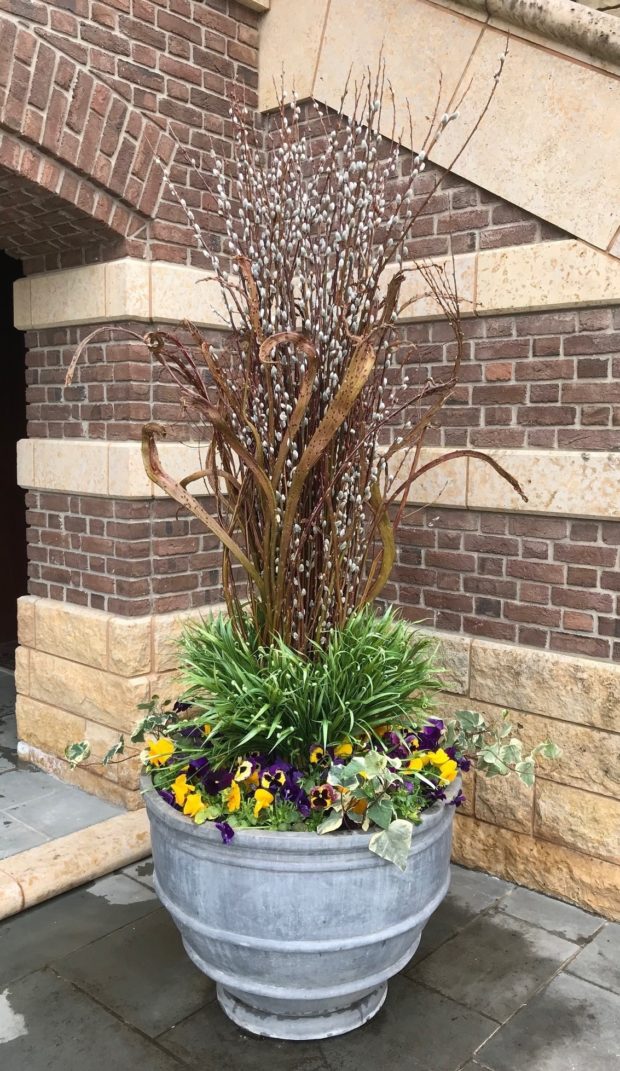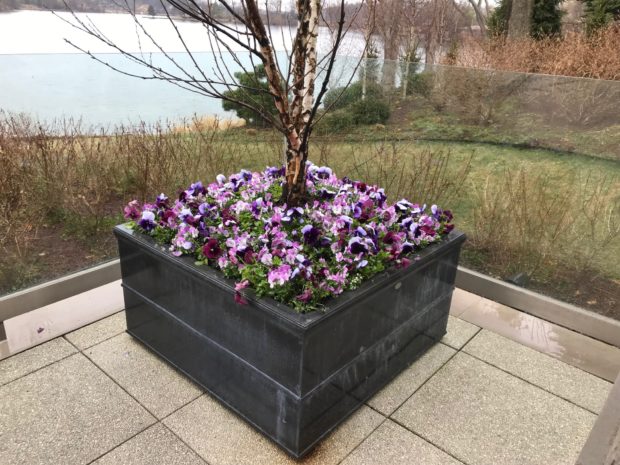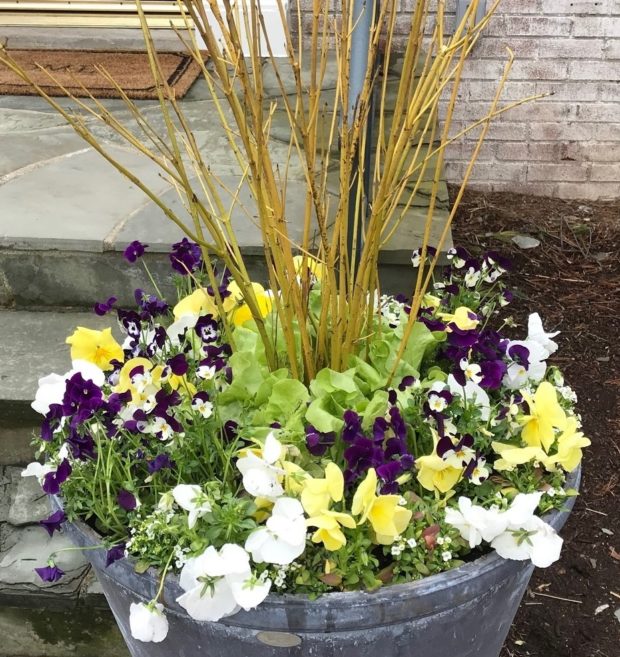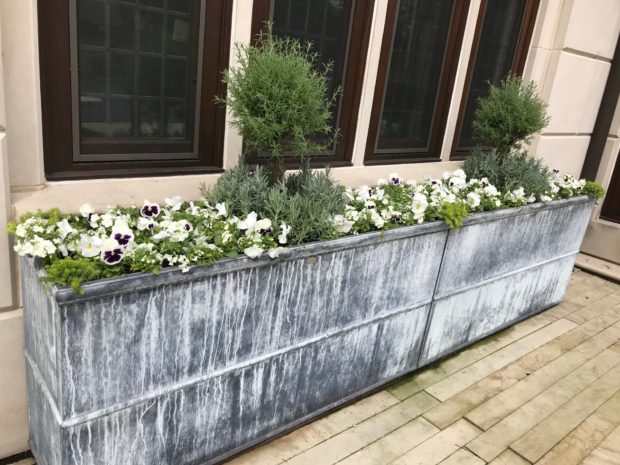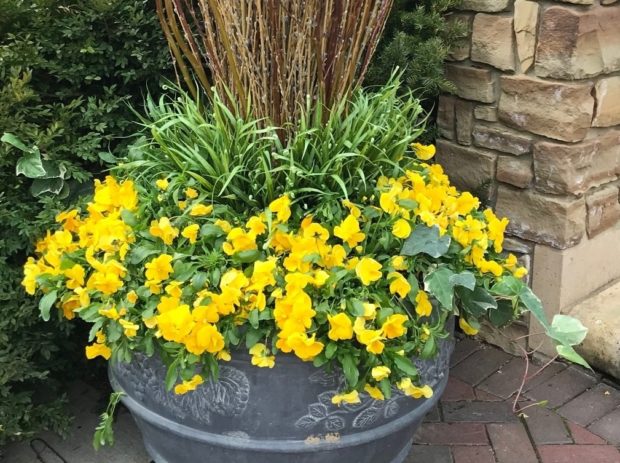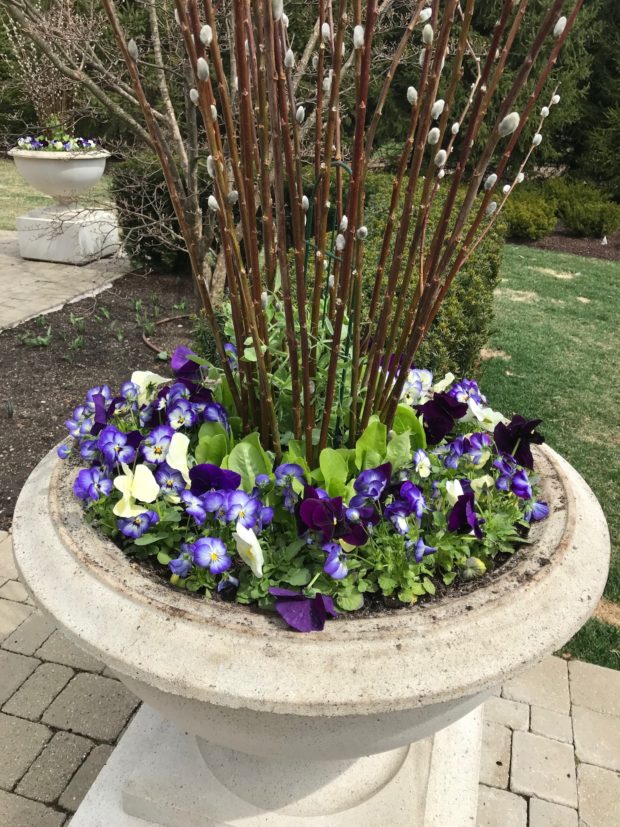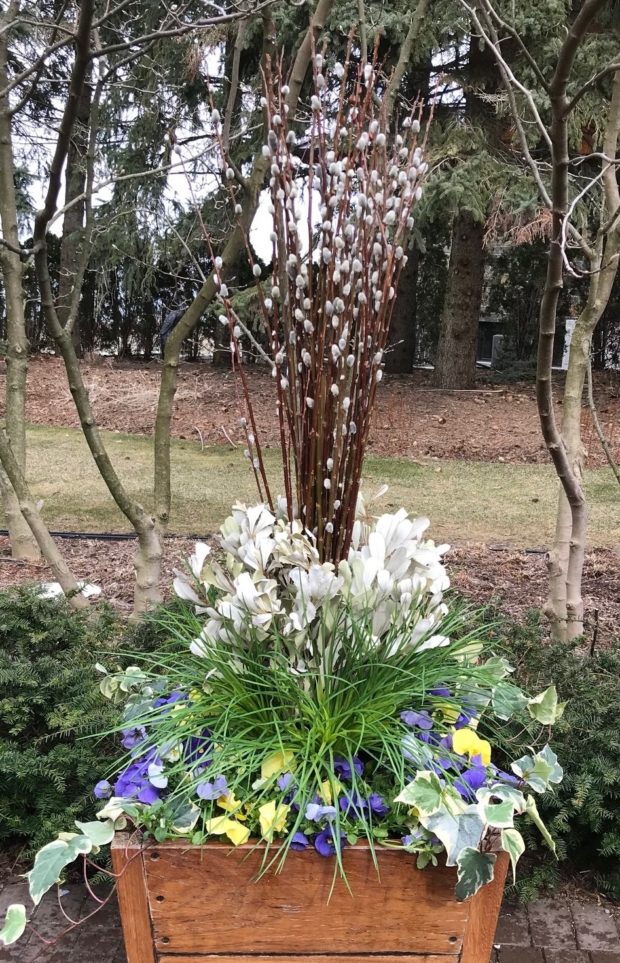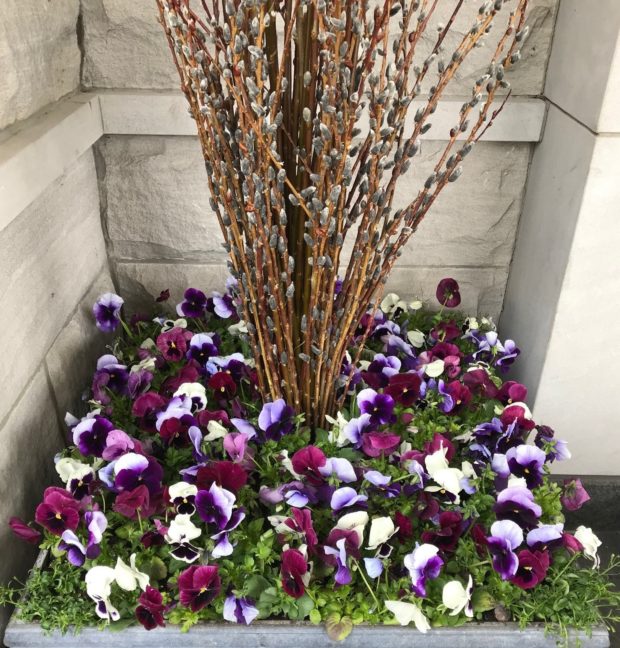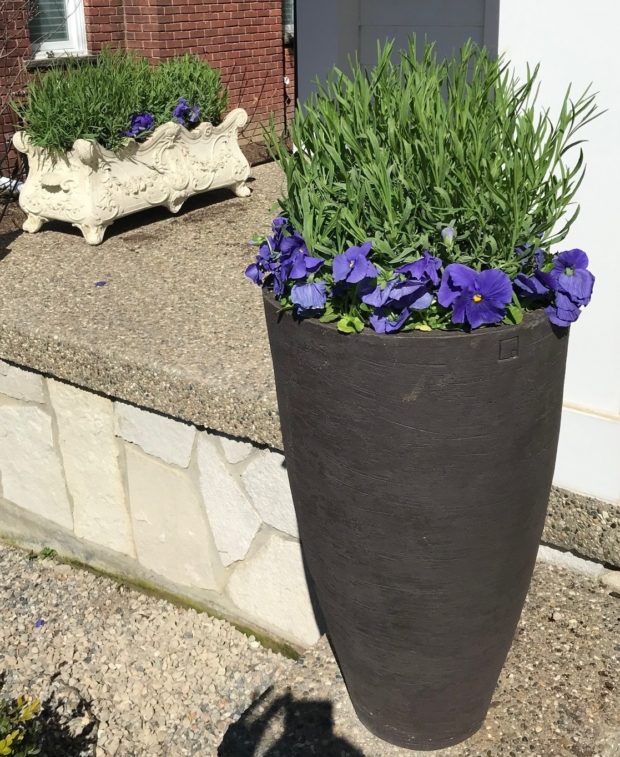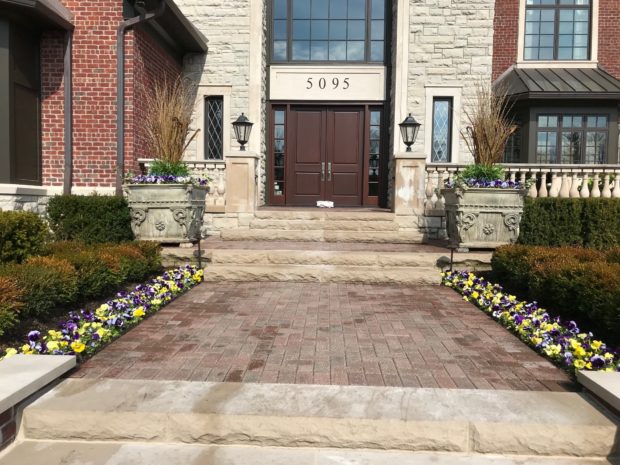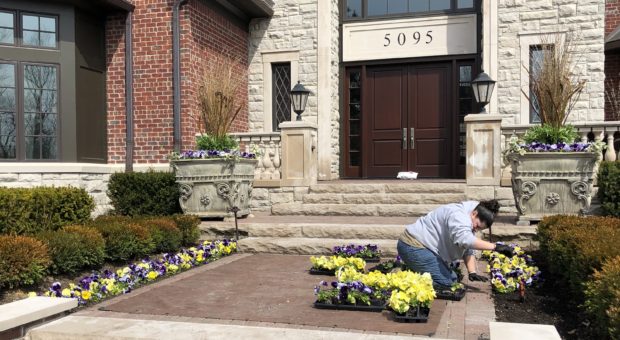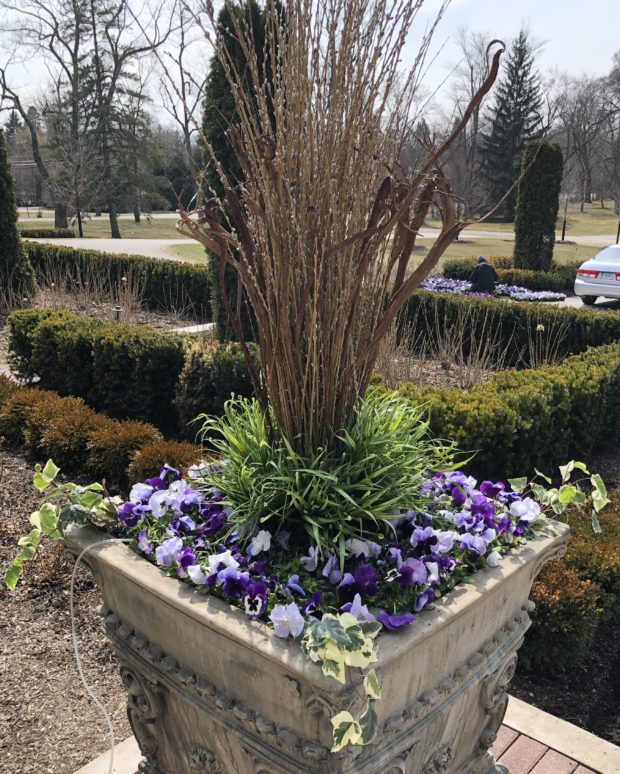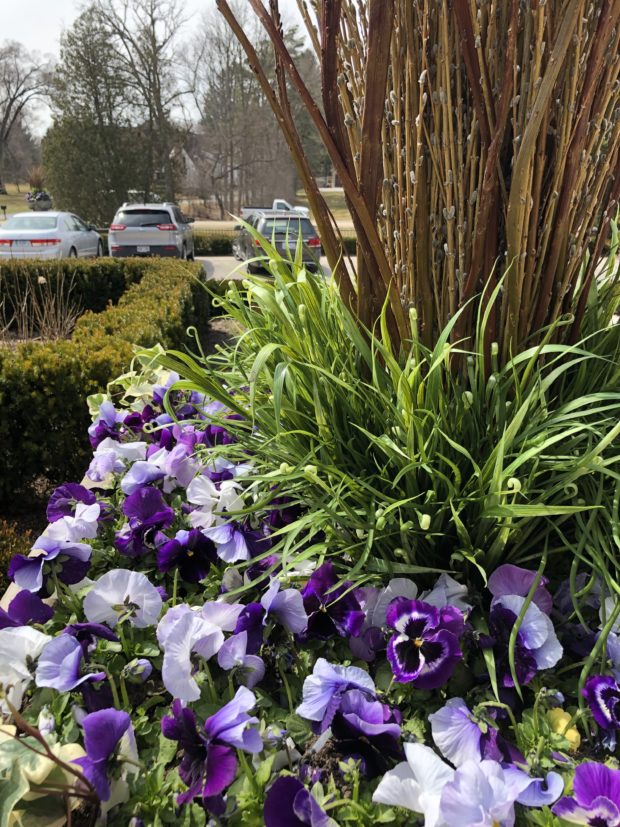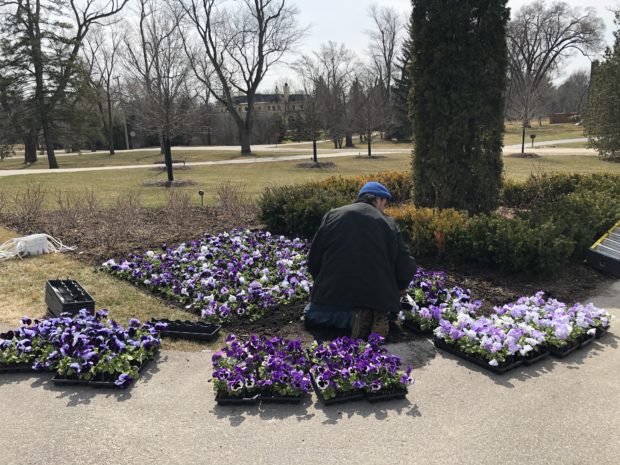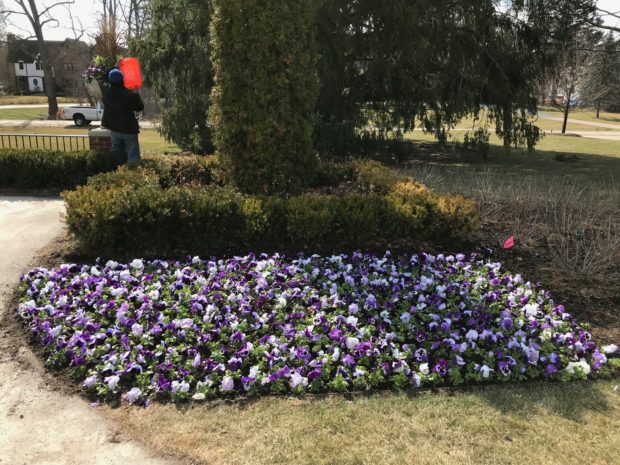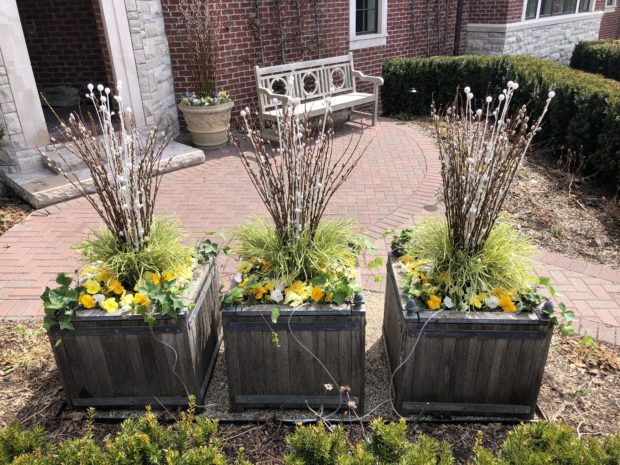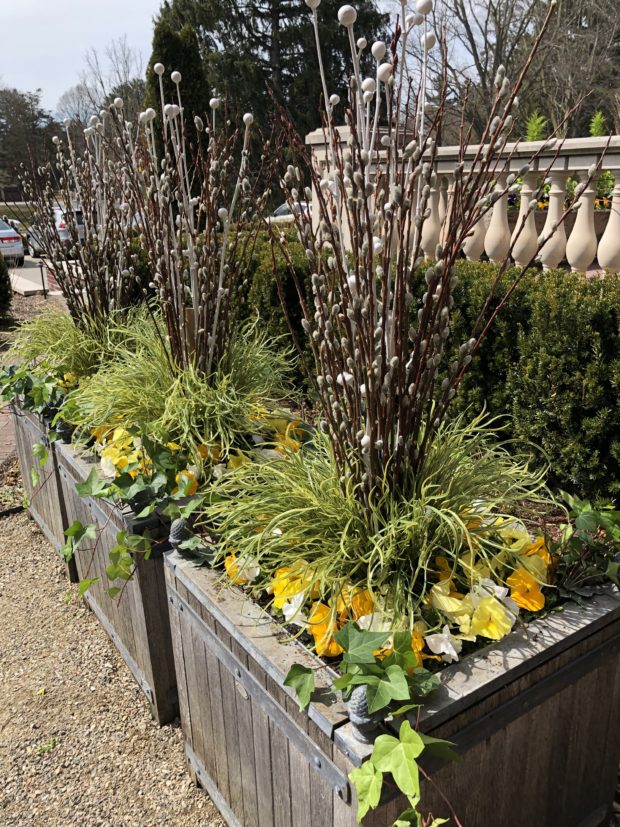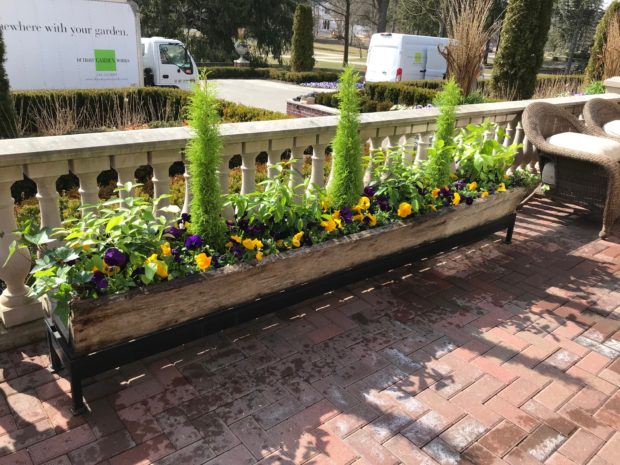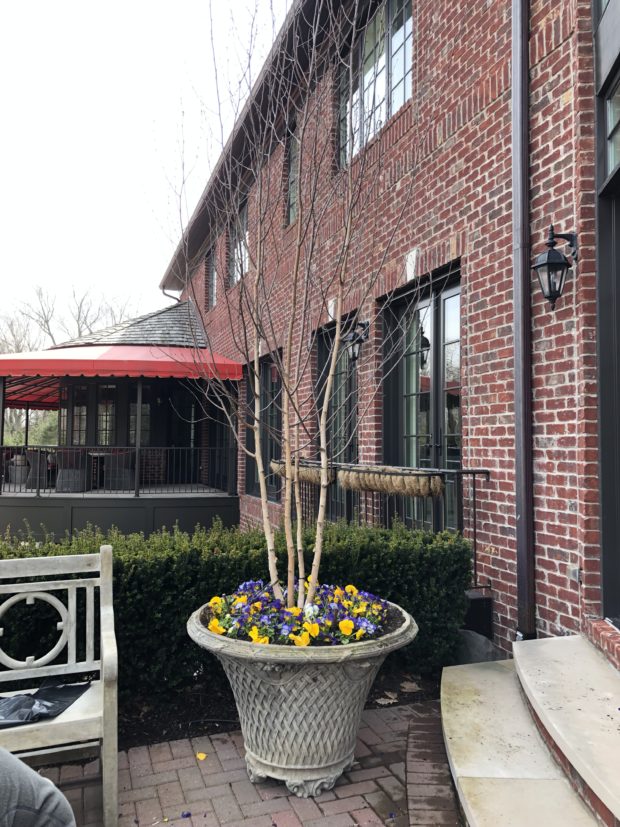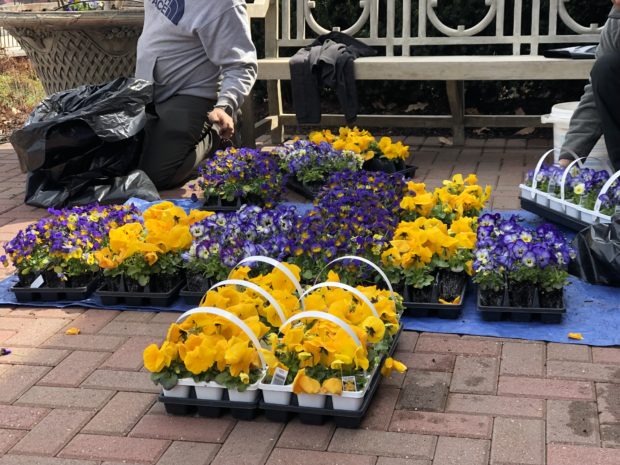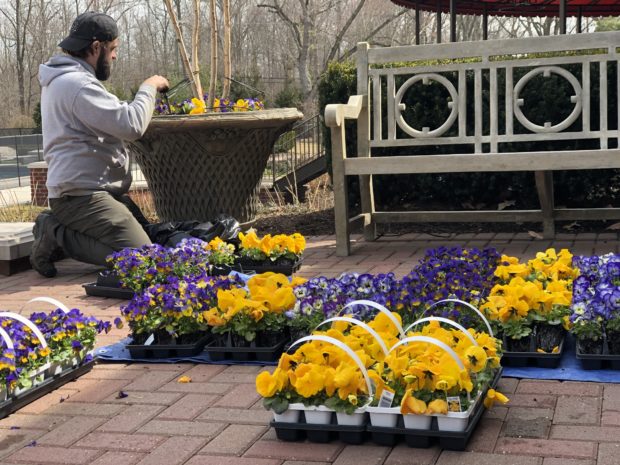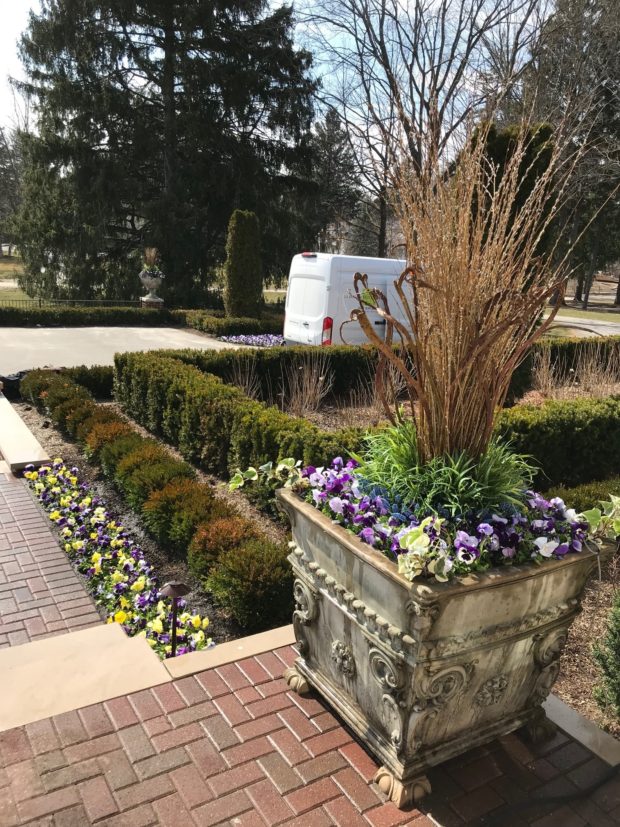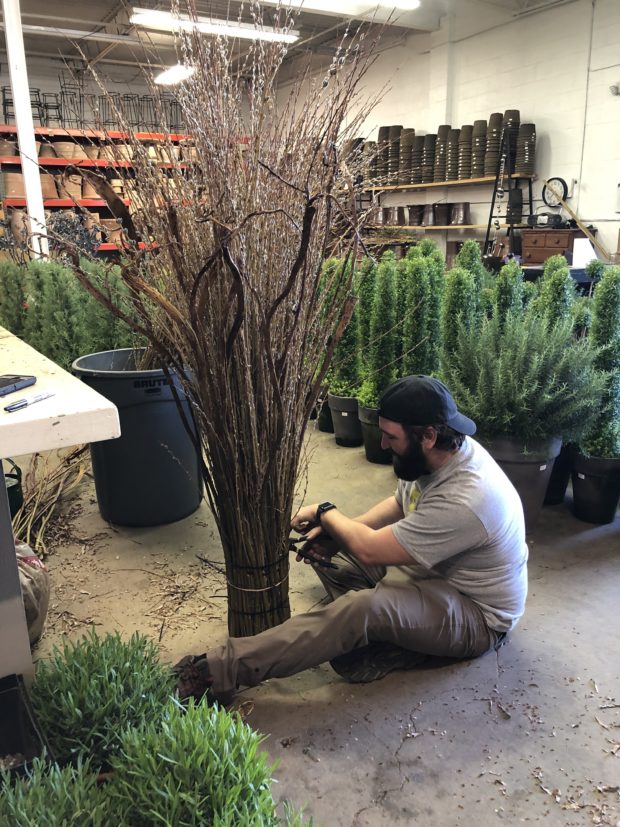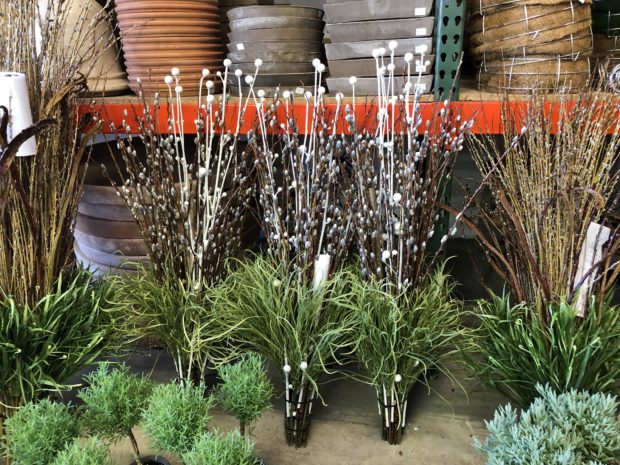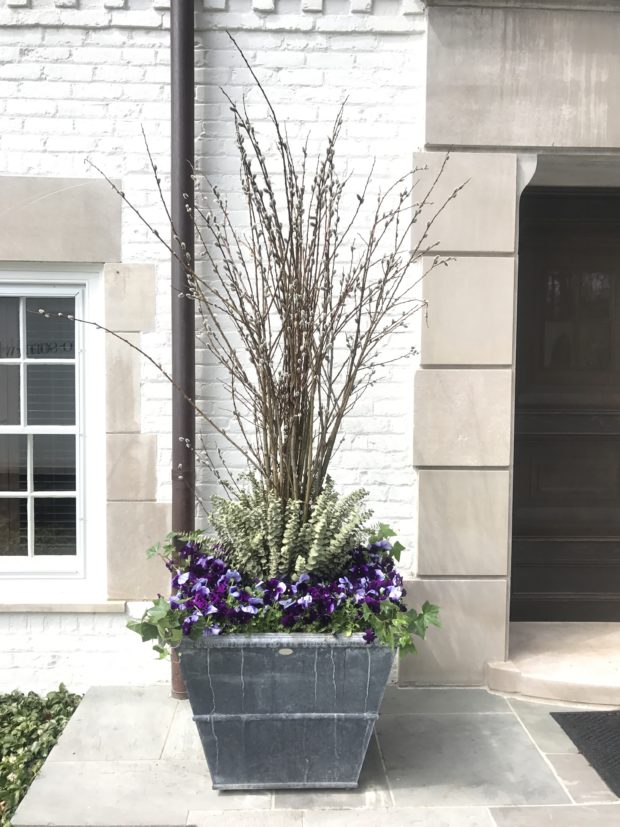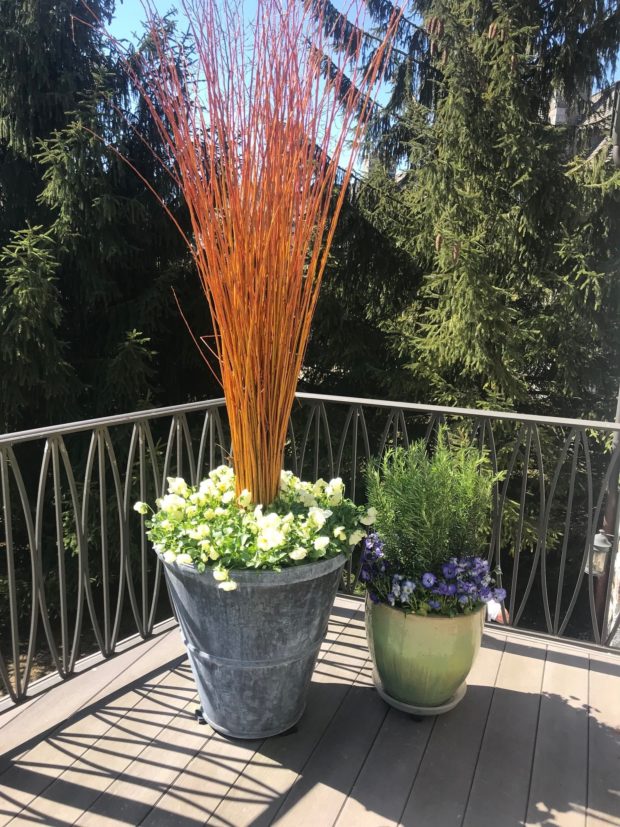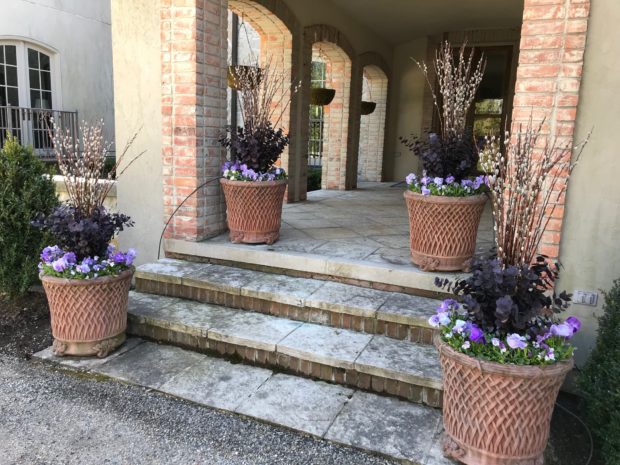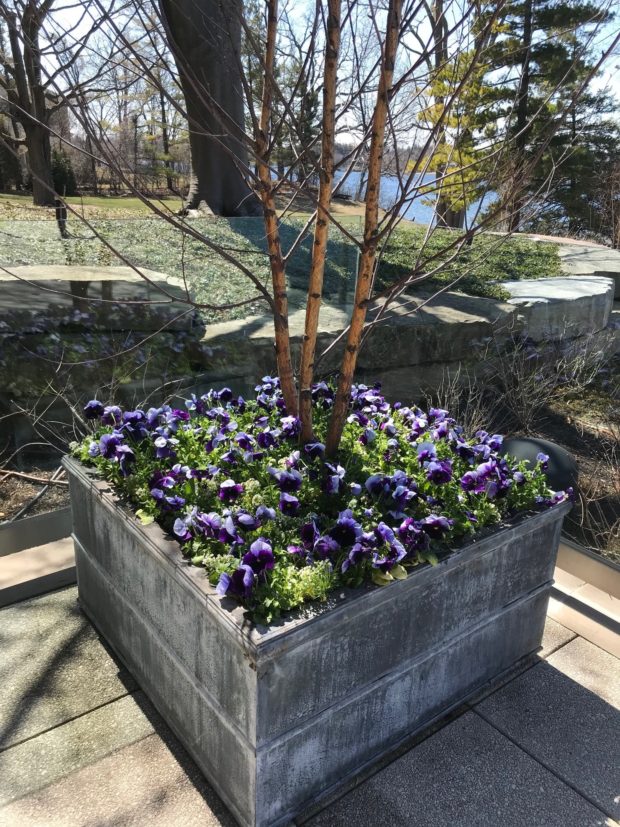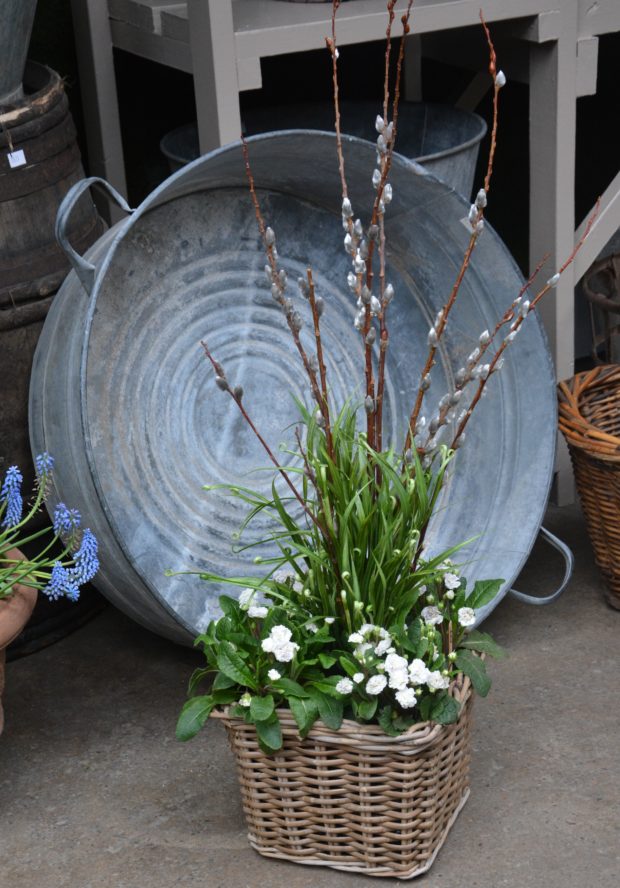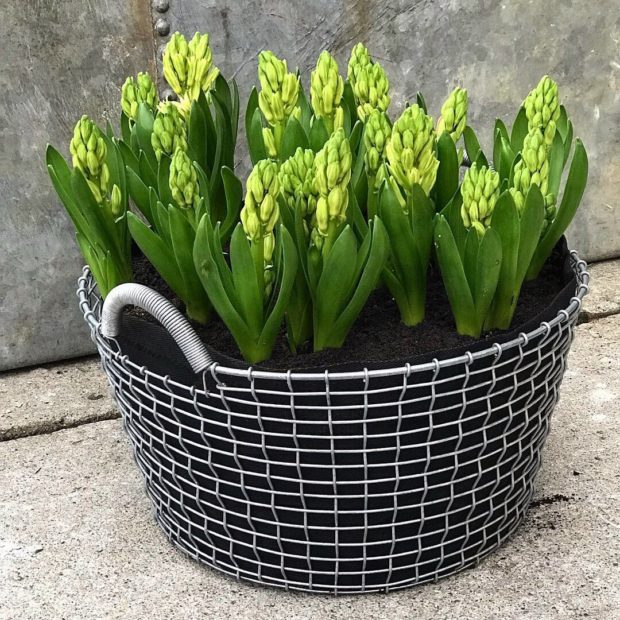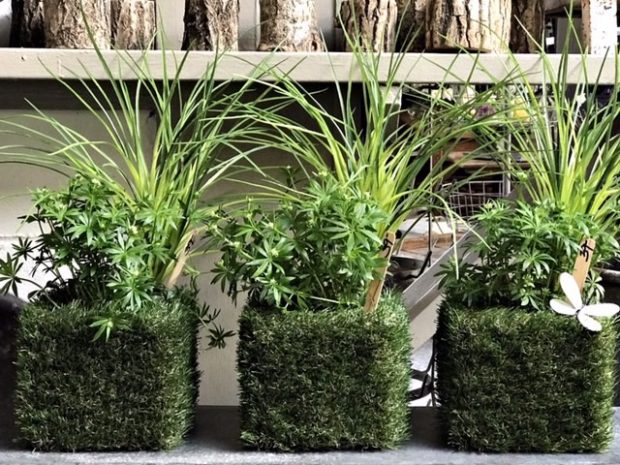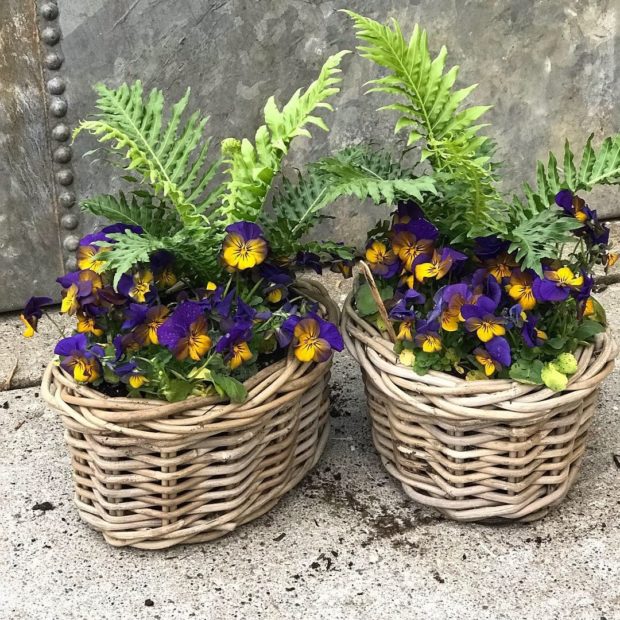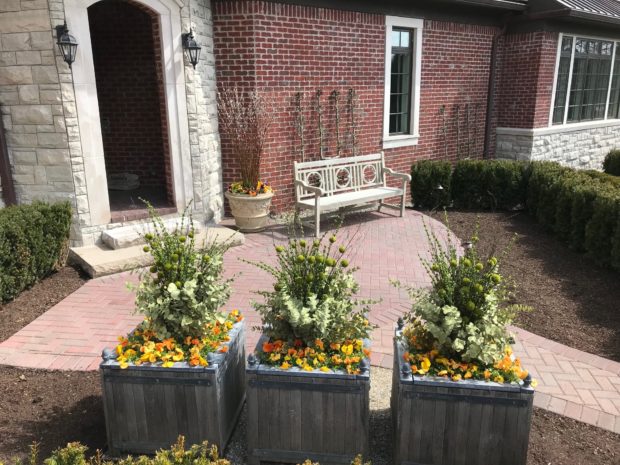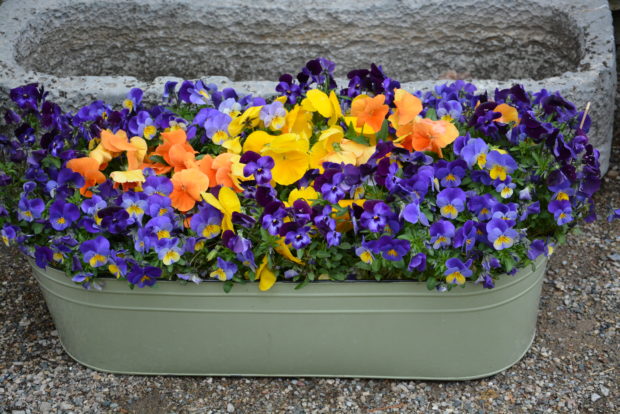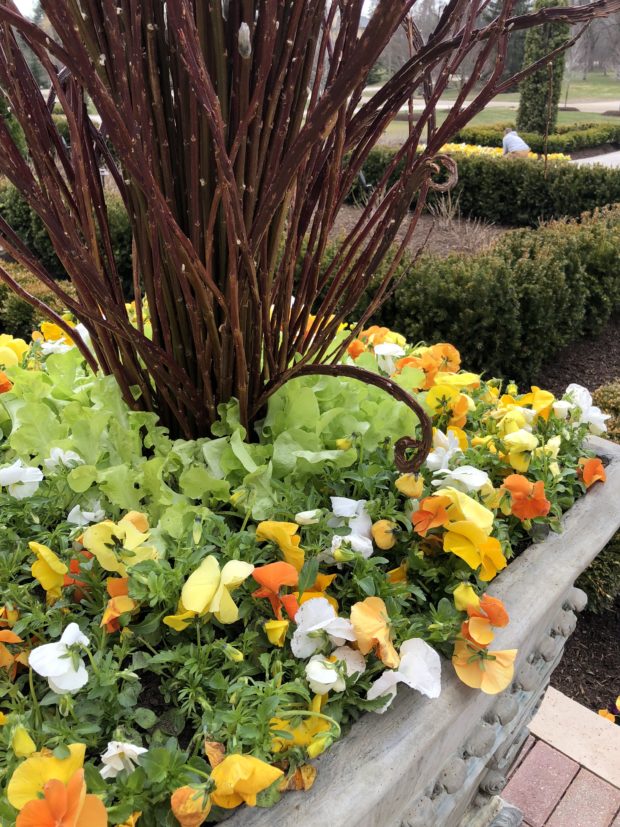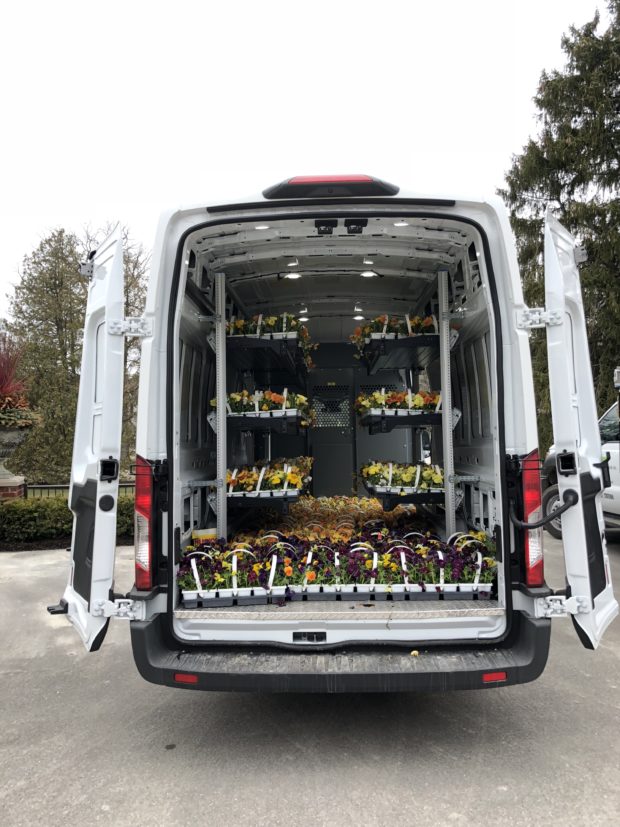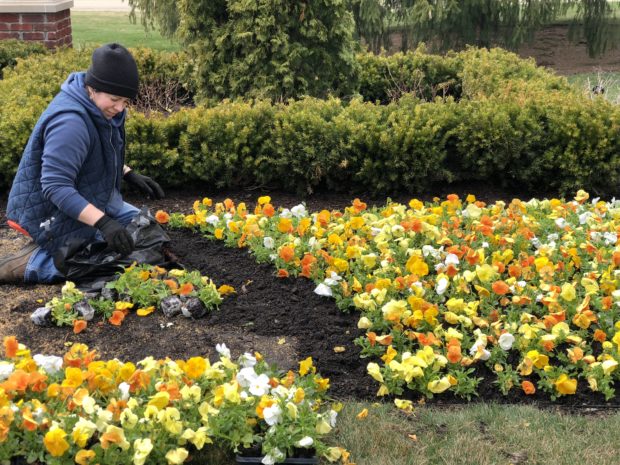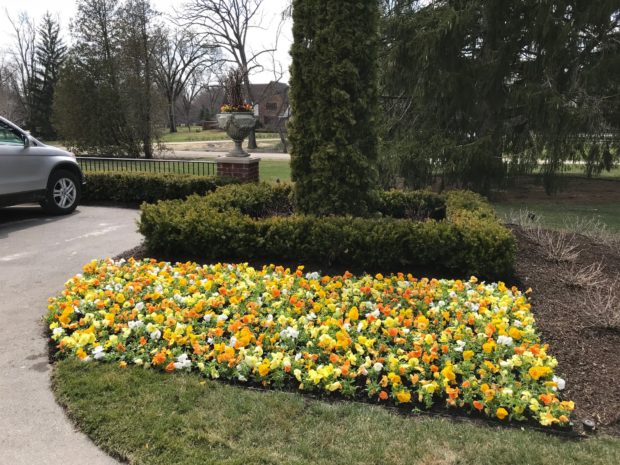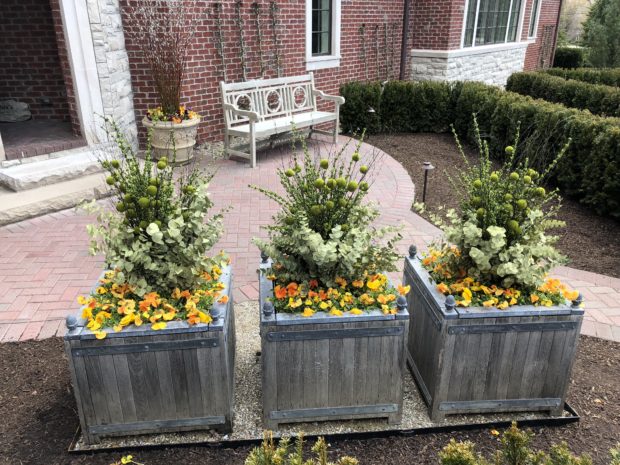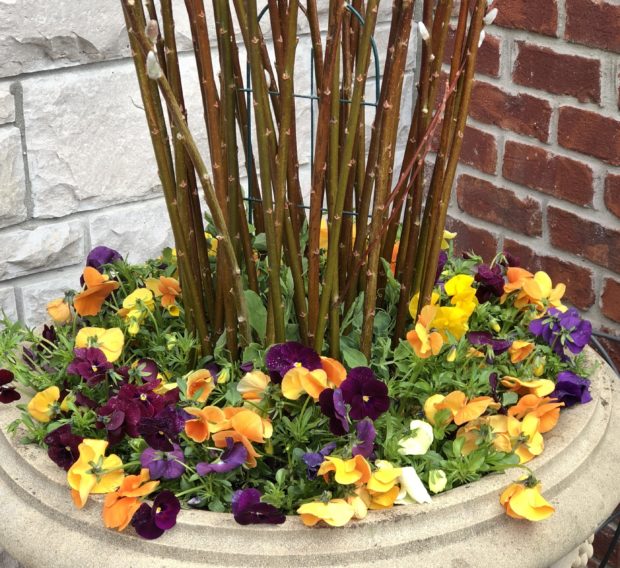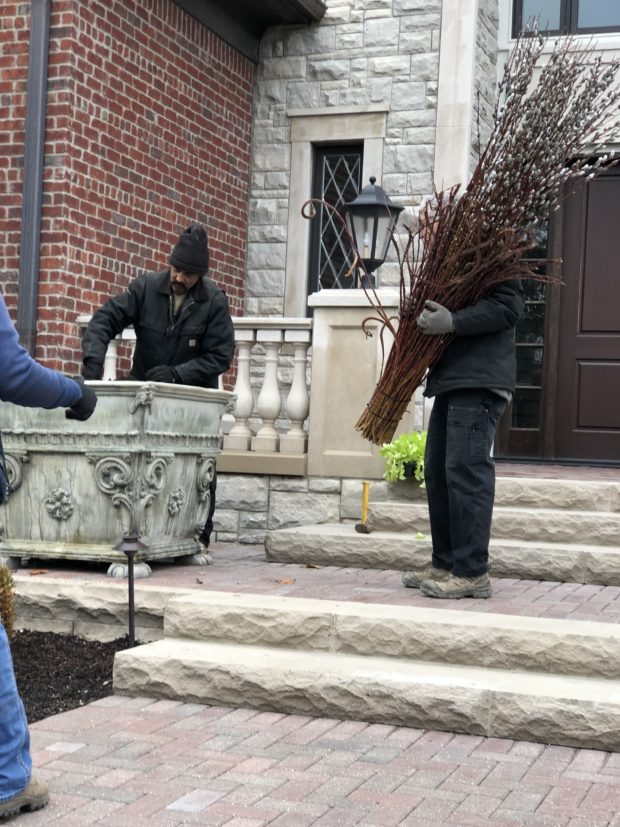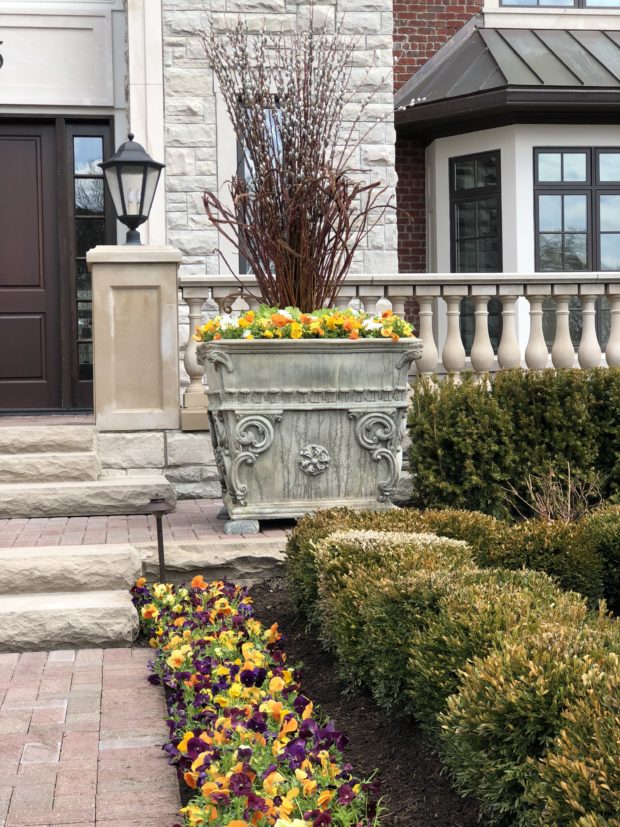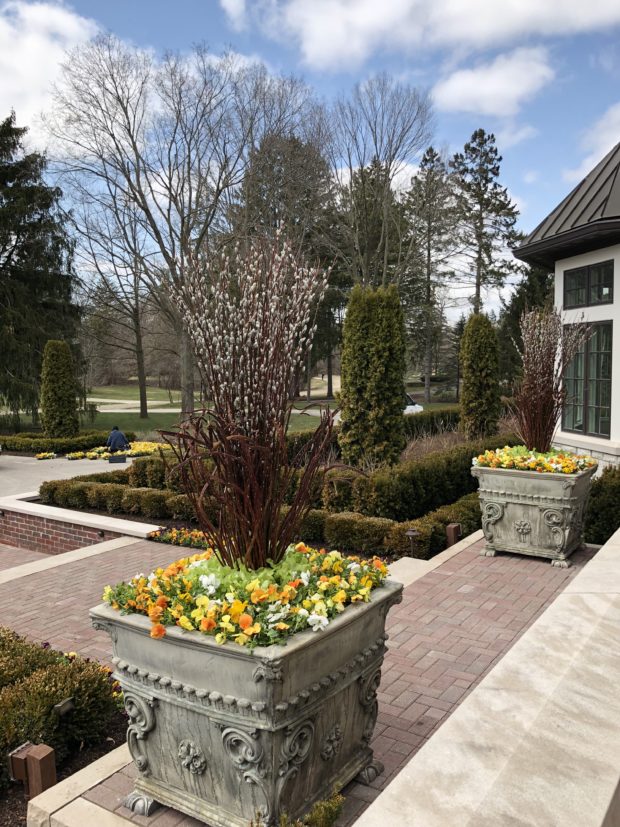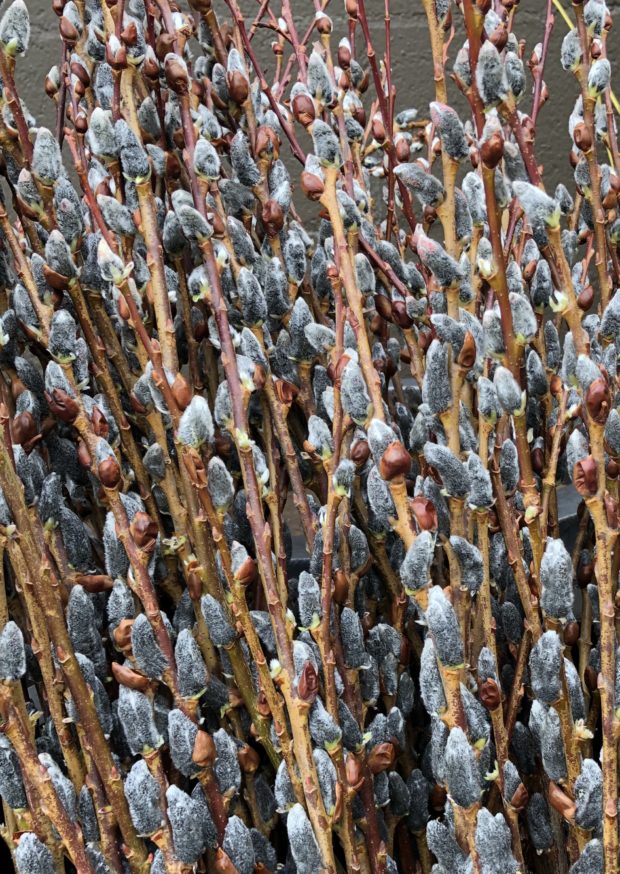 We plant loads of containers in April in celebration of the spring season. The length, depth, and breadth of that planting is informed and driven by those materials available that can tolerate the chill. Farmed twigs are shipped to us in early spring and late fall. They provide mass, volume and height to our container arrangements at a time when the spring season is just beginning. I cannot express how intrigued I was, given a recent and unexpected gift of 50 stems of a new variety of pussy willow. P sent them unannounced, and I was pleased to get them. How gorgeous are these twigs? The white, gray and black catkins are quite unlike any pussy willow I know of. This variation was observed in their field, and the decision was made to propagate the plant. They sent me all of the rest of the stems they had available – 200 – with a promise there would be more available next year.
We plant loads of containers in April in celebration of the spring season. The length, depth, and breadth of that planting is informed and driven by those materials available that can tolerate the chill. Farmed twigs are shipped to us in early spring and late fall. They provide mass, volume and height to our container arrangements at a time when the spring season is just beginning. I cannot express how intrigued I was, given a recent and unexpected gift of 50 stems of a new variety of pussy willow. P sent them unannounced, and I was pleased to get them. How gorgeous are these twigs? The white, gray and black catkins are quite unlike any pussy willow I know of. This variation was observed in their field, and the decision was made to propagate the plant. They sent me all of the rest of the stems they had available – 200 – with a promise there would be more available next year.
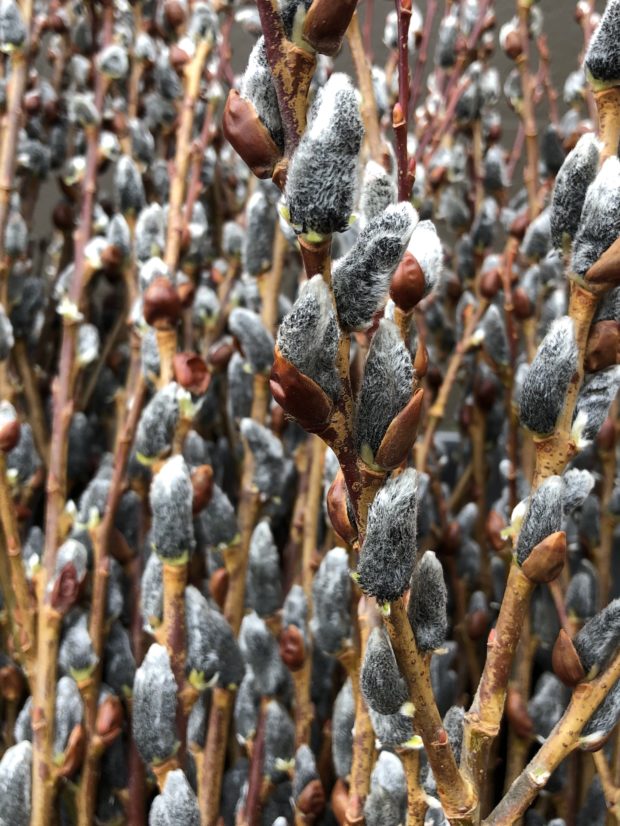 In asking for a potential name for this new cultivar, they adopted Rob’s suggestion. Spring Velvet it is. Aptly named, I think. My suggestion of Spring Sensation was the first thing that came to mind when I saw them. It is so rare that a new plant or cultivar becomes available for early spring containers. That small group of plants (I do include the cut stems of willow and dogwood in that group) that can handle the very early spring weather becomes larger as the weather moderates. April 1, my planting options were limited to twigs and cold grown pansies-provided the night temperatures did not dip below 24 degrees or so. Now, given that is April 15th, we will be able to expand our palette of plants.
In asking for a potential name for this new cultivar, they adopted Rob’s suggestion. Spring Velvet it is. Aptly named, I think. My suggestion of Spring Sensation was the first thing that came to mind when I saw them. It is so rare that a new plant or cultivar becomes available for early spring containers. That small group of plants (I do include the cut stems of willow and dogwood in that group) that can handle the very early spring weather becomes larger as the weather moderates. April 1, my planting options were limited to twigs and cold grown pansies-provided the night temperatures did not dip below 24 degrees or so. Now, given that is April 15th, we will be able to expand our palette of plants.
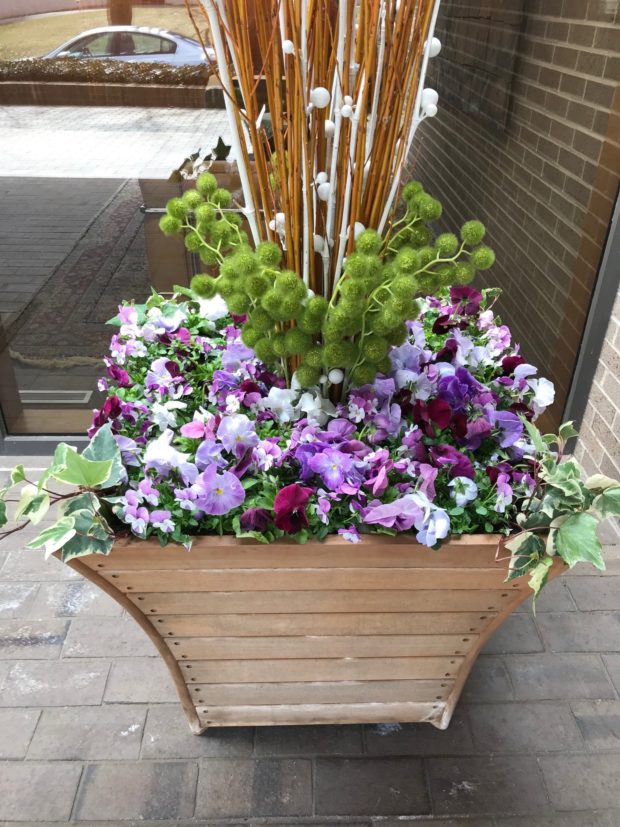 Those first plantings rely on the mix, meaning the mix of colors. I would not have thought that merlot colored pansies would work well with pink wing violas and lavender pansies, but this mix turned out to be surprisingly lively. Does the variegated Algerian ivy get its leaves singed when night temperatures go too low-yes. But the risk is low enough to warrant planting them, and hoping for the best. This planter is on a covered porch, with walls on three sides. The Janet Craig dracaenas we plant here for the summer stay beautiful long into the fall. As for the faux picks, I like what they add to the mix. Green fuzz ball picks and white deco ball stems are graphic and sculptural. They are also whimsical.
Those first plantings rely on the mix, meaning the mix of colors. I would not have thought that merlot colored pansies would work well with pink wing violas and lavender pansies, but this mix turned out to be surprisingly lively. Does the variegated Algerian ivy get its leaves singed when night temperatures go too low-yes. But the risk is low enough to warrant planting them, and hoping for the best. This planter is on a covered porch, with walls on three sides. The Janet Craig dracaenas we plant here for the summer stay beautiful long into the fall. As for the faux picks, I like what they add to the mix. Green fuzz ball picks and white deco ball stems are graphic and sculptural. They are also whimsical.
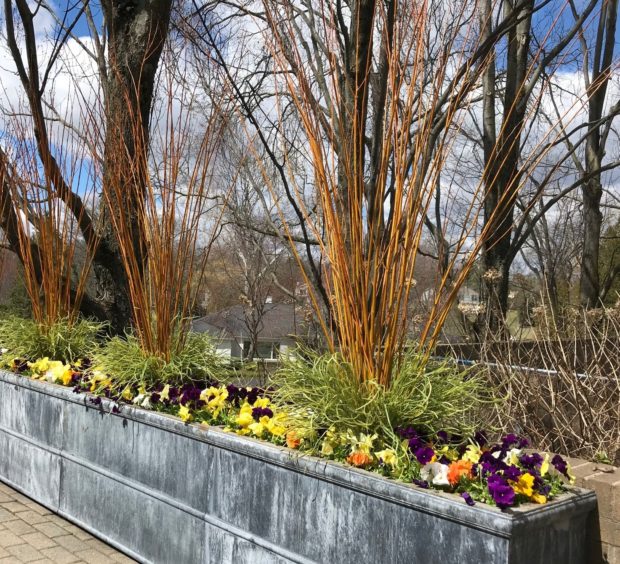 This series of boxes feature the straight and vertical stems of copper willow, and the horizontal layer of pansies. The faux grass picks add a transitional layer that softens that intersection between the copper willow and those pansies. Though the faux grass is faux, they have a relaxed look that is not only believable-it is welcome. Faux grasses have progressed from a stiff and painfully obvious imitation to a graceful and charming representation of what is to come. The signs of spring are still subtle here. Hardy ornamental grasses in my zone will just be waking up the beginning of June. These boxes speak to spring in a brash and sassy way.
This series of boxes feature the straight and vertical stems of copper willow, and the horizontal layer of pansies. The faux grass picks add a transitional layer that softens that intersection between the copper willow and those pansies. Though the faux grass is faux, they have a relaxed look that is not only believable-it is welcome. Faux grasses have progressed from a stiff and painfully obvious imitation to a graceful and charming representation of what is to come. The signs of spring are still subtle here. Hardy ornamental grasses in my zone will just be waking up the beginning of June. These boxes speak to spring in a brash and sassy way.
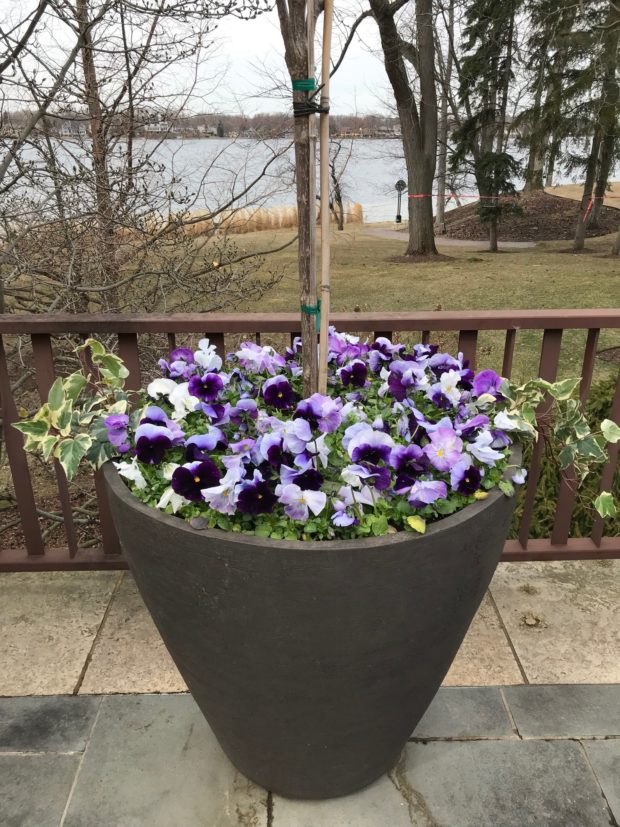 This container features a tree hydrangea which we overwintered inside our unheated landscape building. It will be a while before there are leaves. The process of watching this shrub leaf out is an experience of spring not to be missed. Three cultivars of pansies with closely related color make for a mix that is visually interesting.
This container features a tree hydrangea which we overwintered inside our unheated landscape building. It will be a while before there are leaves. The process of watching this shrub leaf out is an experience of spring not to be missed. Three cultivars of pansies with closely related color make for a mix that is visually interesting.
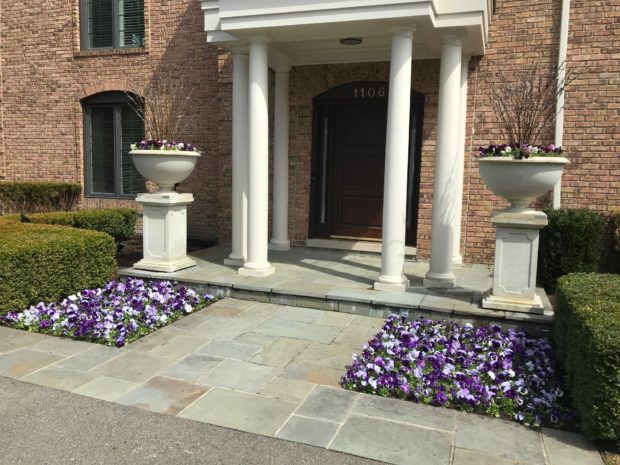 Mixing colors is a way of making familiar materials seem fresh. Once this planting grows in, it will be easier to see that the color in the pots is related to, but different from the pansies in the ground.
Mixing colors is a way of making familiar materials seem fresh. Once this planting grows in, it will be easier to see that the color in the pots is related to, but different from the pansies in the ground.
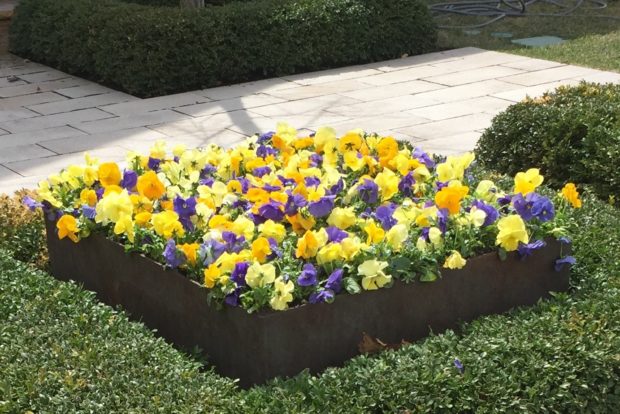 This contemporary spring planting features a color palette notable for its strong contrast.
This contemporary spring planting features a color palette notable for its strong contrast.
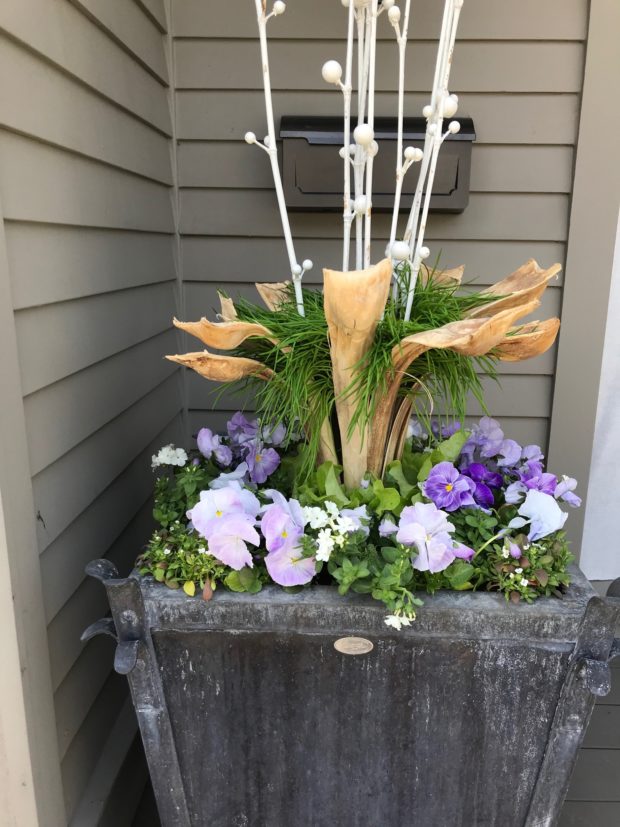 This pot is entirely planted with lavender shades pansy. The color variation is built into the cultivar. The night temperatures had improved sufficiently to permit adding white annual phlox and alyssum to the pansies. All around the contemporary centerpiece-lettuce. The faux grass is very short stemmed and droopy. The paddles are sections of palm leaves that are dried.
This pot is entirely planted with lavender shades pansy. The color variation is built into the cultivar. The night temperatures had improved sufficiently to permit adding white annual phlox and alyssum to the pansies. All around the contemporary centerpiece-lettuce. The faux grass is very short stemmed and droopy. The paddles are sections of palm leaves that are dried.
 This box is in a very protected location. The birds nest ferns will readily handle the chill. The rest of the box is planted with white pansies and alyssum. The texture of the alyssum will soon provide a frothy foil to the broad leaves of the ferns.
This box is in a very protected location. The birds nest ferns will readily handle the chill. The rest of the box is planted with white pansies and alyssum. The texture of the alyssum will soon provide a frothy foil to the broad leaves of the ferns.
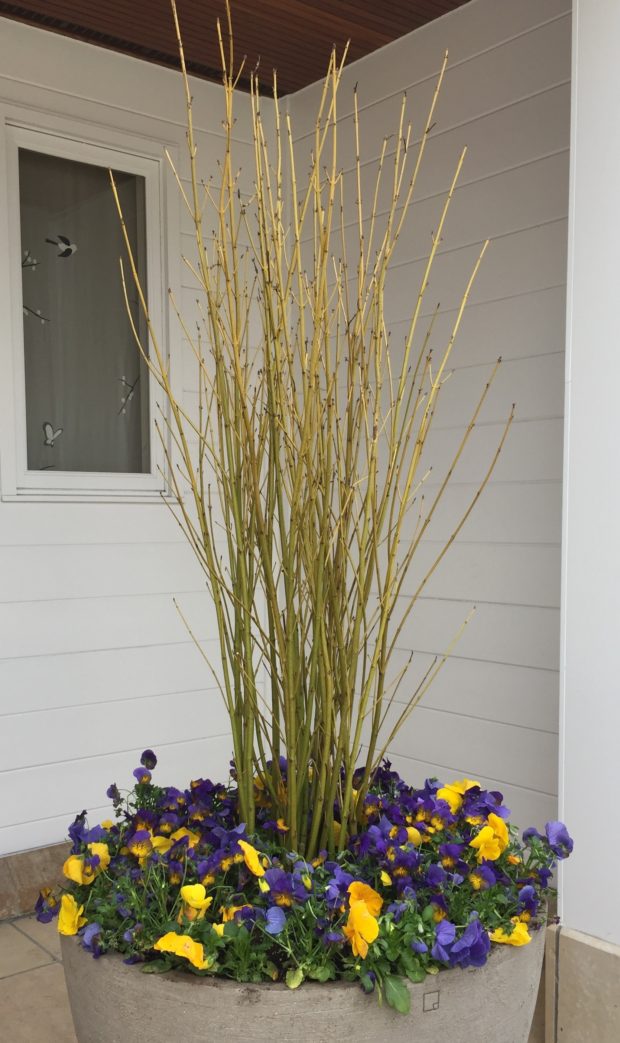 The pansies we carry are sown in October, and overwintered in unheated tunnel houses. It makes sense that our grower has selected varieties that are well adapted to, and thrive under these conditions. Though there are a finite number of pansy and viola cultivars, there are lots of ways in which those cultivars can be combined to achieve a distinctive look. This client likes bold color, and strong contrast.
The pansies we carry are sown in October, and overwintered in unheated tunnel houses. It makes sense that our grower has selected varieties that are well adapted to, and thrive under these conditions. Though there are a finite number of pansy and viola cultivars, there are lots of ways in which those cultivars can be combined to achieve a distinctive look. This client likes bold color, and strong contrast.
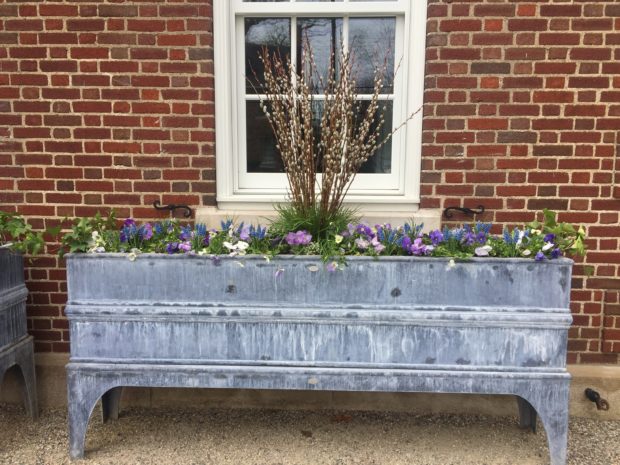 The plants in this box are pastel and pale in color. Once the phlox gets growing, the box will have a volume better proportioned to the size of the box. Looking over pictures of some of the pots we planted last week, they are indeed remarkably different from one another. It is a pleasure to have something to plant in early spring.
The plants in this box are pastel and pale in color. Once the phlox gets growing, the box will have a volume better proportioned to the size of the box. Looking over pictures of some of the pots we planted last week, they are indeed remarkably different from one another. It is a pleasure to have something to plant in early spring.
 This basket is Rob’s planting.
This basket is Rob’s planting.
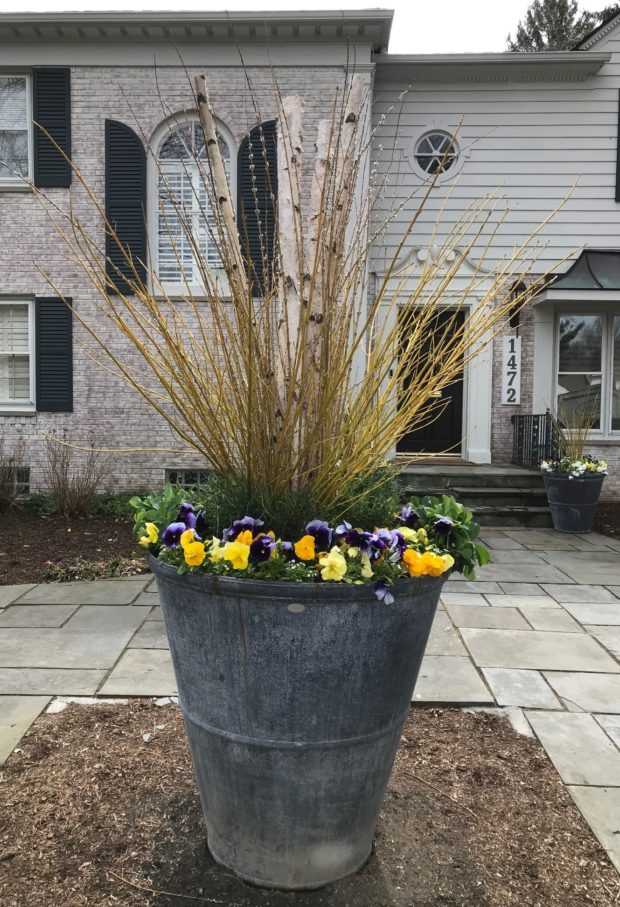 Not only do spring containers represent a preview of what is to come in the landscape and garden, they will just be hitting their glorious best at the end of May and on into June.
Not only do spring containers represent a preview of what is to come in the landscape and garden, they will just be hitting their glorious best at the end of May and on into June.
